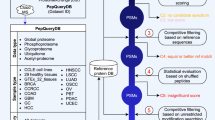Abstract
Matrix-assisted laser desorption/ionization time-of-flight mass spectrometry (MALDI-TOF) is a powerful method to quickly and accurately determine the masses of peptides1. Most genetic analyses, however, begin with PCR amplification of a test sequence to generate DNA, which is more difficult than peptides to analyze by MALDI-TOF2,3. We describe a method that produces a PCR product of any continuous region of coding sequence which can then be used to encode an N-terminally tagged test peptide in a coupled in vitro transcription/translation reaction. The test peptide is purified using the tag, and its mass is measured by MALDI-TOF. Truncations and amino acid substitutions in peptides coded for by the breast cancer susceptibility gene BRCA1 were readily identified using this method. The process can be multiplexed and is amenable to automation, providing an efficient, high-throughput means for mutation discovery and genetic profiling.
This is a preview of subscription content, access via your institution
Access options
Subscribe to this journal
Receive 12 print issues and online access
$209.00 per year
only $17.42 per issue
Buy this article
- Purchase on Springer Link
- Instant access to full article PDF
Prices may be subject to local taxes which are calculated during checkout


Similar content being viewed by others
References
Takach, E.J. et al. Accurate mass measurements using MALDI-TOF with delayed extraction . Protein Chem. 16, 363– 369 (1997).
Berkenkamp, S., Kirpekar, F. & Hillenkamp, F. Infrared MALDI mass spectrometry of large nucleic acids . Science 281, 260–262 (1998).
Nordhoff E., et al. Comparison of IR- and UV-matrix-assisted laser desorption/ionization mass spectrometry of oligodeoxynucleotides. Nucleic. Acids. Res. 21, 3347–3357 ( 1993).
Powell S.M., et al. Molecular diagnosis of familial adenomatous polyposis. N. Engl. J. Med. 329, 1982 (1993 ).
Roest, P.A., Roberts, R.G., Sugino, S., van Ommen, G.J. & den Dunnen, J.T. Protein truncation test (PTT) for rapid detection of translation-terminating mutations Hum. Mol. Genet. 2, 1719–1721 ( 1993).
Brizzard, B.L., Chubet, R.G. & Vizard, D.L. Immunoaffinity purification of FLAG epitope-tagged bacterial alkaline phosphatase using a novel monoclonal antibody and peptide elution. Biotechniques 16, 730– 735 (1994).
Miki, Y. et al. A strong candidate for the breast and ovarian cancer susceptibility gene BRCA1. Science 266, 66– 71 (1994).
Shattuck-Eidens, D. et al. A collaborative survey of 80 mutations in the BRCA1 breast and ovarian cancer susceptibility gene: implications for presymptomatic testing and screening. JAMA 273, 535– 541 (1995).
Garvin A.M. A complete protein truncation test for BRCA1 and BRCA2. Eur. J. Hum. Genet. 6, 226–234 ( 1998).
J.C. Boyer & R.A. Farber . Mutation rate of a microsatellite sequence in normal human fibroblasts. Cancer Res. 58 , 3946–3949 (1998).
Hacia, J.G., Brody, L.C., Chee, M.S., Fodor, S.P. & Collins, F.S. Detection of heterozygous mutations in BRCA1 using high density oligonucleotide arrays and two colour fluoresence analysis. Nat. Genet. 14, 441–447 (1996).
Castilla, L.H. et al. Mutations in the BRCA1 gene in families with early-onset breast and ovarian cancer. Nat. Genet. 8, 387– 391 (1994).
Friedman, L.S. et al. Novel inherited mutations and variable expressivity of BRCA1alleles, including the founder mutation 185delAG in Ashkenazi Jewish families. Nat. Genet. 8, 399– 404 (1994).
Laken, S.J. et al. Genotyping by mass spectrometric analysis of short DNA fragments . Nat. Biotechnol. 16, 1352– 1356 (1998).
Ross, P., Hall, L., Smirnov, I. & Haff, L. High level multiplex genotyping by MALDI-TOF mass spectrometry. Nat. Biotechnol. 16, 1347–1351 (1998).
Acknowledgements
We thank Paul Jeno, Urs Meyer, and Hanno Langen for providing logistical support in Basel.
Author information
Authors and Affiliations
Corresponding author
Rights and permissions
About this article
Cite this article
Garvin, A., Parker, K. & Haff, L. MALDI-TOF based mutation detection using tagged in vitro synthesized peptides. Nat Biotechnol 18, 95–97 (2000). https://doi.org/10.1038/72013
Received:
Accepted:
Issue Date:
DOI: https://doi.org/10.1038/72013



